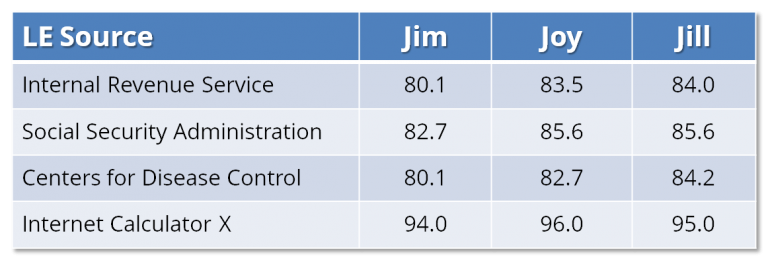
Weiss Education September 2017

New Technologies Give Greater Planning Confidence
September 19, 2017

One of the most important aspects in estate and retirement planning is determining your time horizon. Knowing how long you have to accumulate, distribute and transfer your assets is critical in proper planning.
While numerous planning systems go to great lengths to focus on investment returns, cash flow planning, tax planning, and presentation outputs, little attention is given to determining your planning horizon.
How do you determine the right time horizon? Do you Google it?
Do you guess? Do you assume your lifespan will be the same as your parents?
LongevityQuest has developed myLQAnalysis® using sophisticated biomedical research and advanced data analytics to give you confidence in selecting the right time horizon, so you can calibrate your plan to your lifespan expectation.
The report also includes your rank compared to others your age – which helps you understand how you are doing – and a valuable report of specific biomedical factors that may be adding to, or subtracting from, your lifespan.
Current Approaches
Consumers have access to a wide variety of free calculators and reference tables on the internet. Many use published tables or calculators furnished by a governmental agency such as the IRS, Social Security Administration, or the CDC to find an estimated life expectancy.
Others use free, online calculators from private organizations such as insurance companies, wellness centers or such. These sources can yield wide discrepancies in the results.
Case Studies
To show you how they differ, let’s look at 3 case studies.

Jim was 54 and Joy 37 when considering the life expectancy. Results from their labs and measurements showed that every single marker was in the normal range. Most LE sources would agree that they would have excellent life expectancy.
Jill on the other hand was 52 with only three out of range results – a slightly elevated liver function and high cholesterol/LDL. Her ratios were very good, and was actually given a Preferred rate class on a life insurance policy right after her lab tests.
Look at these life expectancy (LE) calculations from various sources. There is significant variation – up to 14 years difference and that can have a huge impact on planning.
Now see how the science behind LongevityQuest viewed them.

Tragically, Jill passed away even earlier than her scientific life expectancy, with significant issues identified in areas that fell into normal ranges using traditional observation (Jill's biomedical information was used post mortem in the research that created the technology – see mylongevityquest.com for more details).
All 3 by traditional observation methods were similar but their individual scientific profiles were quite different.
New Technologies
LongevityQuest collaborated with experts in biomedical diagnostics, actuarial science and mortality risk assessment to create myLQAnalysis.
This report uses new technologies now available to present the wellness and risk analysis in a way that transforms the data from biometric testing into a clear picture of your longevity expectation and peer ranking while identifying key factors that may be adding to or subtracting from your lifespan.
The Analysis incorporates a revolutionary biomedical data analytics program developed by ExamOne/Quest Diagnostics® that utilizes sophisticated multivariate statistical and actuarial models proven in healthcare research and validated by examining millions of individual cases with biomedical data against official Social Security Administration and multiple carrier mortality records.
Originally developed to be a tool for risk evaluation for life insurance companies, the models focus on the combination and inter-connected aspects of body systems with more than 140 variables, and are dramatically improved over traditional approaches of interpreting laboratory results and physical measurements.
Greater Confidence in Planning
LongevityQuest's LEAnalysis provides far more insight than life expectancy. Remember that life expectancy is when 50% of those like you have died, and 50% are still living, so you have a 50% chance of living past life expectancy. For case study Jim, his life expectancy was calculated to be 93.62.
The What are my odds? online tool allows him to see probabilities at any age. In fact, Jim's report says that he has a 15% chance of living to 104. For retirement planning, he can be 85% confident of not needing income to last longer than to 104.
 With the What are my odds? online tool, you can select the time horizon you want to use based upon the probabilities you are comfortable with, giving you a risk-adjusted horizon.
With the What are my odds? online tool, you can select the time horizon you want to use based upon the probabilities you are comfortable with, giving you a risk-adjusted horizon.
Over time, as you continue to monitor your plan and have repeat Analysis reports, you can adjust the time horizon based upon your updated biomedical analysis.
Tools for Wellness
The Analysis includes the myLQRank® report, a patent-pending calculation of how your lifespan compares to others. Tracking your Rank over time can be an easy way to see if your wellness efforts are paying off.
It also includes the myLQFactors® report that identifies specific biomedical factors and their calculated impact on your lifespan – perfect for sharing with your doctor to address any concerns that may have been identified.
Until next time,
David Phillips